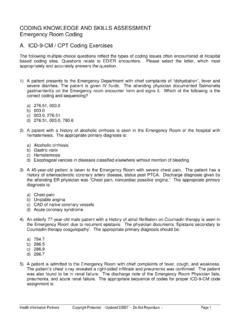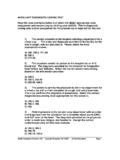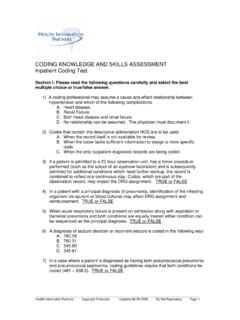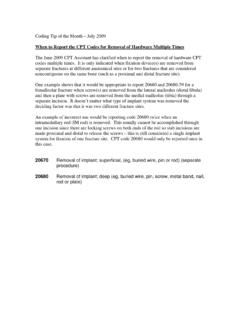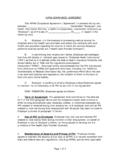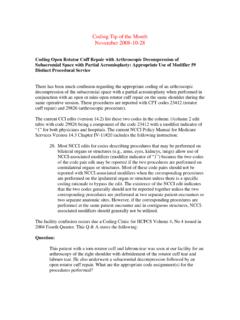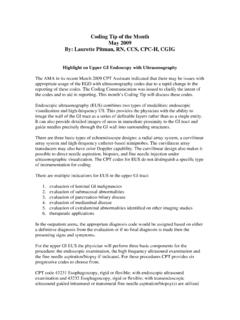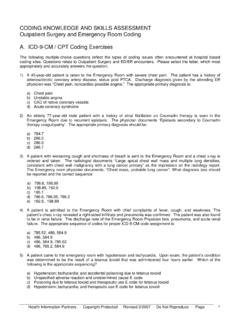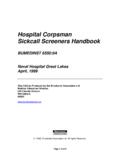Transcription of CODING KNOWLEDGE AND SKILLS ASSESSMENT …
1 CODING KNOWLEDGE AND SKILLS ASSESSMENT . Physician Side CODING Section A Multiple Choice: Select the Best Answer 1. For a comprehensive review of systems, the physician may only document All Systems Negative . a. True b. False 2. A new patient requests a consult for a second opinion on lung cancer. A code from which category would be assigned? a. Office Visit, New Patient b. Office Visit, Established Patient c. Office Consult, New Patient d. Inpatient Consult, New Patient 3. According to the 1995 E/M guidelines, a comprehensive exam can be obtained with the following documentation?
2 A. Head, neck, eyes, ears, CV, respiratory, abdomen, skin b. Chest, Breast, 4 extremities, CV, skin, neuro, GU. c. Eyes, Ears, LN's, CV, GI, GU, skin, neuro, psych d. Detailed skin exam, LN's, Back, Musculoskeletal, CV. 4. According to the 1997 E/M guidelines an extended HPI can be obtained with the following documentation? a. 4 elements of the HPI. b. Status of 3 chronic conditions c. Status of 3 inactive conditions d. All of the above 5. A new patient is seen for a consultation during their hospital admission.
3 The physician sees the patient in the office 1 week following discharge for follow up. A code from which category would be assigned for the follow up visit. a. Office Visit, New Patient b. Office Visit, Established Patient c. Office Consult, Established Patient d. Subsequent Hospital Care _____. Health Information Partners Copyright Protected Updated 10/16/2007 Do Not Reproduce Page 1. 6. The physician may bill separately for a gastric intubation, CPT code 43752, when done at the same time critical care services are provided, CPT code 99291?
4 A. True b. False 7. A women presents for her annual well women exam. During the exam, her hypertension and diabetes are addressed. Can the physician bill a separate office visit E/M in addition to the preventive medicine E/M if the key components are documented for the hypertension and diabetes ASSESSMENT ? a. Yes b. No 8. CPT procedure code 12031 has a global period of how many days? a. 0. b. 10. c. 30. d. 90. 9. A physician performs a TKA. 5 weeks later, the total knee arthroplasty becomes infected and the patient is taken to surgery to remove all of the components of the arthroplasty.
5 Which modifier will be appended to the code for the removal of the TKA? a. No modifier required b. Modifier 22. c. Modifier 78. d. Modifier 79. 10. According to CPT guidelines, what is the correct way to report a bilateral breast reduction? a. 19318 x 2 units b. 19318-RT and 19218-LT. c. 19318 and 19318-50. d. 19318-50. Section B Line CODING : Assign CPT codes with appropriate modifier if applicable (include anatomical modifiers). 1. Twelve actinic keratoses removed from the back by cryosurgical destruction. 2. LHC for coronary angiogram only.
6 Interpretations and Supervision by physician. 3. Closure of cm foot wound with Dermabond (Non-Medicare patient). 4. Electroencephalogram with patient awake and asleep. Interpretations and Supervision by physician. _____. Health Information Partners Copyright Protected Updated 10/16/2007 Do Not Reproduce Page 2. 5. Cautery of 1 cm open nose wound. 6. Interpretation with report of EKG tracing. 7. Office follow up 6 weeks after THA. PF hx, EXP exam, and SF MDM documented. 8. Replacement of dual chamber pacemaker generator.
7 9. Left heart catheterization, coronary angiograms, left ventriculography. Interpretation and supervision by physician. Section C Injections and Infusions: Assign CPT codes with appropriate modifier if applicable. Assume all injections and infusions are performed/supervised by the physician. 1. Intramuscular injection of human rabies immune globulin. 2. TD vaccination, preservative free 10 year old boy given IM. 3. IVP of Toradol at 11:00 and Demerol at 12:00. 4. IV Infusion of Cipro from 10:00 11:30. 5. IV Infusion of Levaquin from 7:45 8:25 and IVP of Zofran.
8 6. IV Infusion of NS for dehydration from 12:32 1:15, IV Infusion of Rocephin from 1:45. 2:30, IVP of Benadryl at 2:55. 7. IV Infusion of NS for hydration from 9:05 9:55 and IV Infusion of 5-Fluorouracil from 10:00 11:55. Part IV Case Studies: Code the following cases with ICD-9-CM diagnosis codes, CPT procedure codes, and applicable modifiers for physician reimbursement. For E/M, use 1997 guidelines. Follow CPT guidelines (not payor specific guidelines), appropriate NCCI edits, and add anatomical modifiers. Assign Medicare G-codes instead of CPT code if appropriate.
9 Assume only interpretation and supervision for all radiology procedures. Case #1: Preoperative Diagnosis: Basal Cell Carcinoma and Pigmented Nose Lesion. Postoperative Diagnosis: Same Procedure Performed: Excision of Lesions x 2 and Advancement Flap. Findings: 2 cm left cheek lesion and 1 cm nose lesion. Pathology: Specimen A: x x cm lesion, basal cell carcinoma. Specimen B: x x cm lesion, seborrheic keratosis. _____. Health Information Partners Copyright Protected Updated 10/16/2007 Do Not Reproduce Page 3. The patient was prepped and draped in sterile fashion in the supine position and administration of anesthesia was done.
10 Lidocaine with epinephrine was infiltrated into the skin surrounding the lesions. An elliptical transverse incision was made to fully excise the nose lesion with 1 mm margins. Interrupted 6-0 Nylon sutures were then placed to close the skin defect. Next, the cheek lesion was addressed and an elliptical transverse incision was made to fully excise the cheek lesion. This was taken to the deep subcutaneous tissue to ensure removal of the carcinoma. The lesion was removed with 2mm margins. Frozen section came back basal cell carcinoma and the margins were clear.
